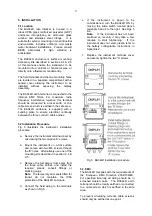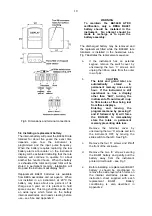
2
1. Description
2. Operation
2.1 Controls
2.2 Displays
3. Intrinsic Safety Certification
3.1
ATEX certificate
3.2
Internal battery
3.3
Pulse input terminals
3.3.1 Voltage pulse
3.3.2 Contact or open collector
3.4 Remote
reset
terminals
3.5 Zones, gas groups and T rating
3.6 Certification label information
4.System Design for Hazardous Area
4.1
System certificates
4.2
Use with Zener barriers
4.3
Use with galvanic isolators
5. Installation
5.1
Location
5.2
Installation procedure
5.3 EMC
5.4 Installing a replacement battery
5.5 Disposal of used batteries
6. Programming and Calibration
6.1
Calibration structure
6.2
Accessing programme functions
6.3
Summary of programmable
functions.
6.4
Display update interval
6.5
Type of input
6.6 Position of the decimal points
6.7 Lower
display
6.8
Rate scale factor
6.9
Timebase
6.10 Rate filter
6.11 Total scale factor
6.12 Clip-off
6.13 Local reset
6.14 Resetting grand total
6.15 Security code
7. Calibration Example
7.1
Calibration procedure
8. Maintenance
8.1
Fault finding during commissioning
8.2
Fault finding after commissioning
8.3
Servicing
8.4
Routine maintenance
8.5
Guarantee
9. Accessories
9.1
Units of measurement and
instrument identification.
9.2
Alarms
9.2.1 Solid state output
9.2.2 Intrinsic safety
9.2.3 Programming and
adjustment
9.2.4 Alarm enable
9.2.5 Type of alarm
9.2.6 Setpoint adjustment
9.2.7 Alarm function
9.2.8 Alarm output status
9.2.9 Hysteresis
9.2.10 Alarm delay
9.2.11 Alarm silence time
9.2.12 Access setpoint
9.2.13 Adjusting alarm setpoints
from display mode.
9.3 External push-buttons
9.4 Pipe mounting kits
9.5 Stem mounting kit
10. Index
Appendix 1
ATEX dust certification
Appendix 2
BA491 replacement battery
CONTENTS
The BA344D is CE marked to show compliance with the
European Explosive Atmospheres Directive 94/9/EC
and the European EMC Directive 2004/108/EC
Summary of Contents for BA344D
Page 13: ...13...



































